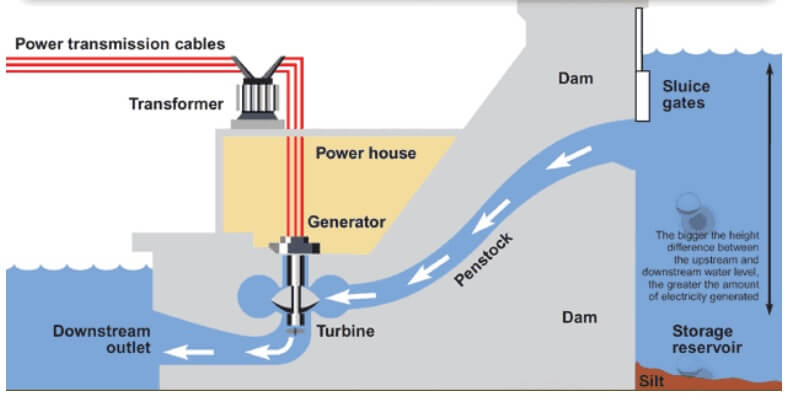In Hydro electric power plants the energy of water is utilized to move the turbine which intern run the electric generators.
Hydraulic energy is converted into Mechanical energy by the turbines, when coupled with generator produces the power.
Features of Hydro electric power plants:
- Large investments
- Long gestation period
- Increased cost of power transmission
Hydro Electric Power Plant – Main Components
- Reservoir – Basin formed by the construction of a dam; it holds back a very large volume of water so that the flow rate can be controlled.
- Water intake – Structure that directs water from the headbay to the penstock to power the plant.
- Penstock – Channel that carries water under pressure to the power plant’s turbines.
- Draft tube – Conduit at the base of the turbine that increases the runner’s output by reducing the pressure of the water as it exits.
- Generator unit – Device with a turbine that transmits the water’s mechanical energy to the generator’s rotor to make it turn to produce electricity.
- Transformer – Device used to alter the electric voltage; voltage is increased as the current leaves the power plant so that it can be carried over long distances.
Hydro Electric Power Plant – Advantages
- Once a dam is constructed, electricity can be produced at a constant rate.
- If electricity is not needed, the sluice gates can be shut, stopping electricity generation. The water can be saved for use another time when electricity demand is high.
- Dams are designed to last many decades and so can contribute to the generation of electricity for many years / decades.
- The lake that forms behind the dam can be used for water sports and leisure / pleasure activities. Often large dams become tourist attractions in their own right.
- The lake’s water can be used for irrigation purposes. The build up of water in the lake means that energy can be stored until needed, when the water is released to produce electricity.
- When in use, electricity produced by dam systems do not produce green house gases. They do not pollute the atmosphere.
Hydro Electric Power Plant – Disadvantages
- Dams are extremely expensive to build and must be built to a very high standard.
- The high cost of dam construction means that they must operate for many decades to become profitable.
- The flooding of large areas of land means that the natural environment is destroyed.
- People living in villages and towns that are in the valley to be flooded, must move out. This means that they lose their farms and businesses. In some countries, people are forcibly removed so that hydro power schemes can go ahead.
- The building of large dams can cause serious geological damage. For example, the building of the Hoover Dam in the USA triggered a number of earth quakes and has depressed the earth’s surface at its location.
- Dams built blocking the progress of a river in one country usually means that the water supply from the same river in the following country is out of their control. This can lead to serious problems between neighboring countries.
- Building a large dam alters the natural water table level. For example, the building of the Aswan Dam in Egypt has altered the level of the water table. This is slowly leading to damage of many of its ancient monuments as salts and destructive minerals are deposited in the stone work from ‘rising damp’ caused by the changing water table level.
Classification of Hydro Electric Power Plant
Storage plant
- High head plants (1000 m and above)
- Medium head plants (50 to 500 m)
- Low head plants (below 50 m)
- Run of river power plants
- With pondage
- Without pondage
- Pumped storage power Plants
Run off river without pondage
- These plant does not store water
- The plant has no control over the flow of river
- Therefore, water head is wasted during low head and high flood conditions
- During dry season the capacity of the plant goes down
- The utility of these plants are very less due to non uniformity of supply.
Pump storage plant
- In this type, water from upper reservoir is released to lower reservoir for a shorter period to generate
large quantity of electricity - Pumping from lower reservoir to upper reservoir is done in off peak hours
- Pump storage plants are generally used for peak loads
- The power of pumping water is used when it is cheaper.






